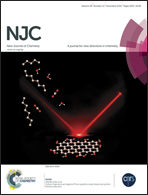A label-free electrochemistry biosensor based flower-like 3-dimensional ZnO superstructures for detection of DNA arrays
Abstract
A novel label-free DNA hybridization biosensor was fabricated using flower-like 3-dimensional (3D) ZnO superstructures as an enhanced sensing platform and employing chitosan (CS) as a film-forming material. A highly sensitive electrochemical DNA sensor was constructed by homogenously distributing Au nanoparticles (AuNPs) on the ZnO–CS matrix. The electrochemical performance of the designed electrodes was investigated by cyclic voltammetry (CV) and electrochemical impedance spectroscopy (EIS). Differential pulse voltammetry (DPV) was used to monitor DNA hybridization. The AuNPs/ZnO–CS film exhibited good conductivity for accelerating the electron transfer, which led to obvious signal amplification and a low detection limit for electrochemical sensing. Under optimal conditions, the peak currents of the redox marker exhibited a linear relationship with the logarithm of the concentrations of complementary DNA from 1.0 × 10−14 to 1.0 × 10−10 M with a detection limit of 2.0 × 10−15 M (3σ/S). The developed sensor also displayed high selectivity to differentiate one-base mismatched DNA. The excellent performance of the biosensors was attributed to large surface-to-volume of ZnO superstructures and the synergistic effect of AuNPs and CS. The proposed approach provides a simple and reliable method for DNA detection and will open new opportunities for the sensitive detection of other nucleic acids.


 Please wait while we load your content...
Please wait while we load your content...